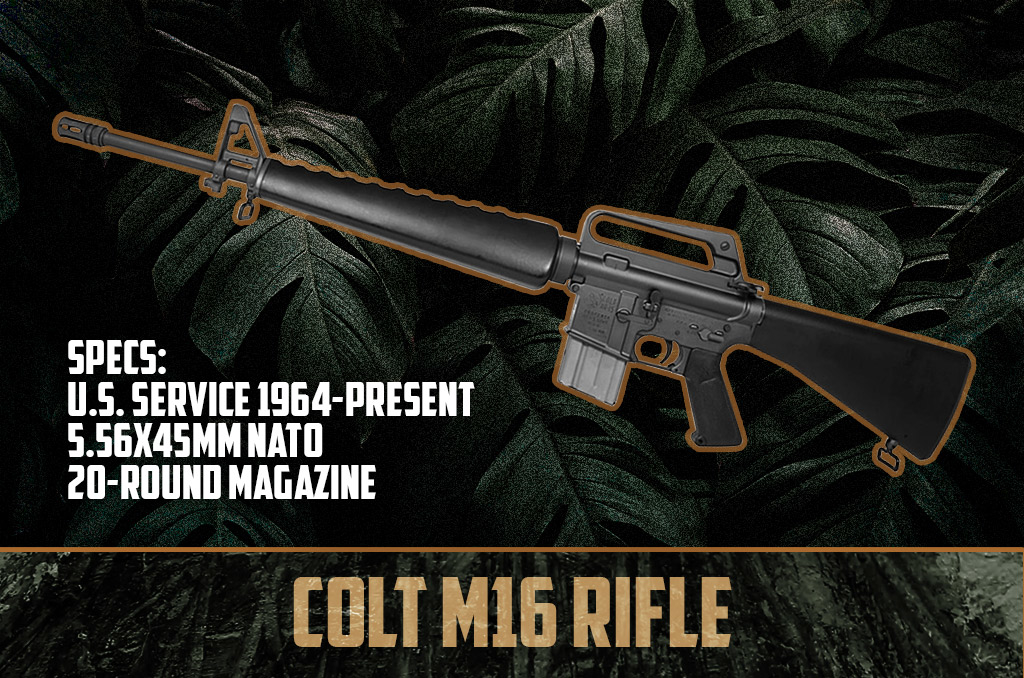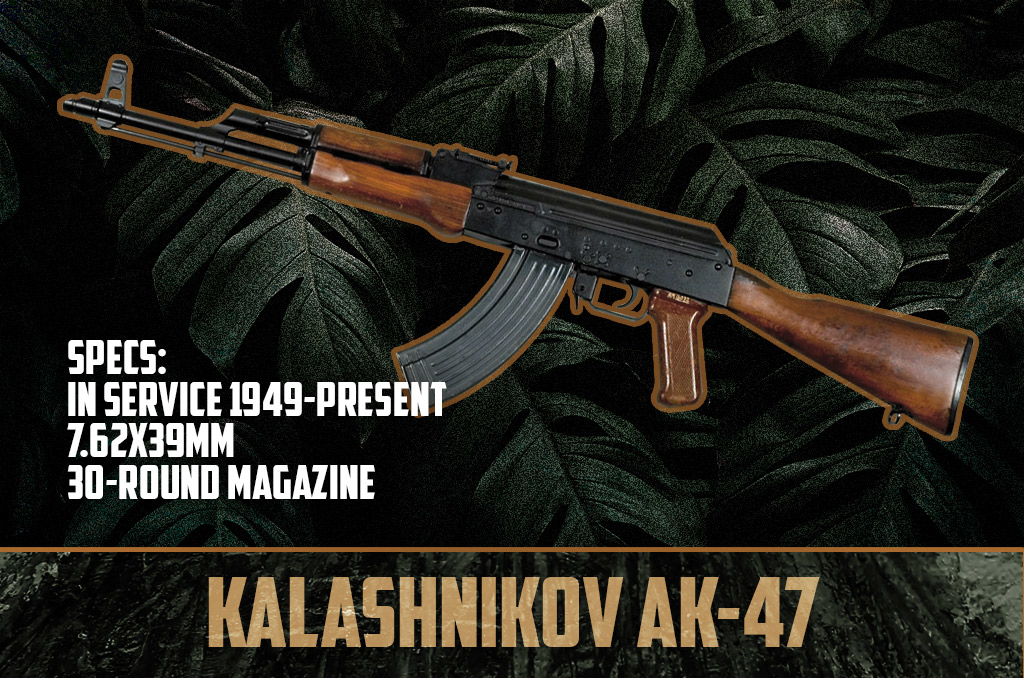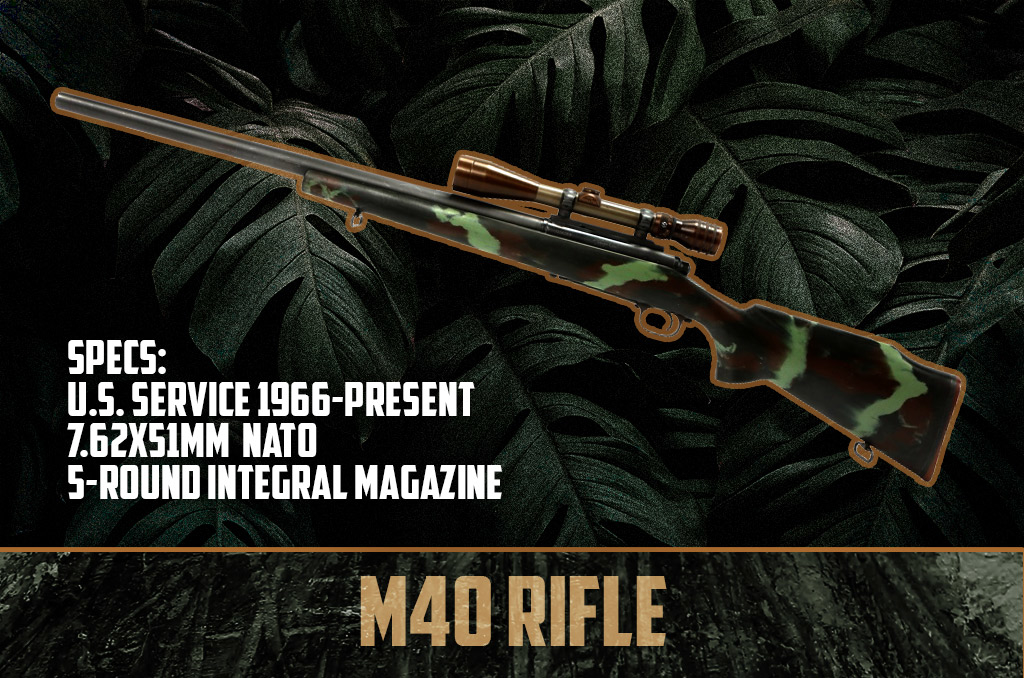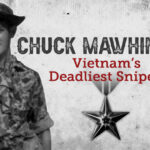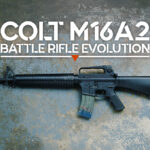

Run Through The Jungle: Vietnam War Weapons
The brutality of the Vietnam War was the defining event of a generation. The decade long war unfolded during a time of cultural divide in the U.S. with mass media echoing voices of the counterculture in disapproval. Arts and entertainment became politicized with events like Woodstock ’69, resulting in some of the most influential work from musicians, filmmakers, and artists of the 20th century.
Militarily, the war taught Western powers many lessons in guerrilla tactics. Lessons that resonate today with our conflicts in the Middle East and Southwest Asia. Urban fighting in small spaces against combative armed peasants became the new standard. Although a lot has evolved since the 1960s and 1970s in combat armaments, modern small arms have a direct lineage similar to those used five and six decades ago. Let’s take a look at the legendary Vietnam war weapons which for many were the face of the war.
Vietnam War Battle Rifles
Colt M16
The UH-1 Iroquois helicopter, much more commonly known as the “Huey,” is the only military item more associated with Vietnam war weapons than the M16.
Although the M16 has been mass-produced for the U.S. military by Colt, Colt did not design them. The rifle was not designed to use the 5.56X45mm cartridge.
The original design by Eugene Stoner was actually the AR-10, designed for the 7.62X51mm. That was the caliber to be used in the general-purpose machine gun project which would ultimately be the M60. In the end, the Army selected the select-fire M14. It was really just a rechambered M1 Garand which had been retrofitted with a detachable box magazine.
The M14 is a great weapon, but it was an awful load when humping it in the boonies. The rifle runs about 9 pounds without a magazine. Add a full mag and bipod, you’re up to more than 11 pounds total. This heavyweight precluded patrolling soldiers from carrying it in the quantities needed to match up against NVA soldiers with AK-47 and SKS rifles using the more compact 7.62X39mm.
The AR-10 was reassessed and found to be scalable down to the much lighter 5.56X45mm. Not only was the ammunition much lighter, but the rifle itself was over 30% lighter than the M14. This was because of the advanced use of plastics in the stock and forearm.
M-16 Issues On The Battlefield
M16s were originally cursed in the field due to their sensitivity to wet and dirty conditions. Early adopters on the battlefield lost faith in the rifle, resorting to any alternatives they could get their hands on for running patrols. The problems associated with the original XM16E1 and the issued ammo were ironed out in the M16A1, namely a new chrome chamber and bore. New training programs were also put in place, including more rigorous cleaning practices.
Not surprisingly, whether or not the 5.56X45mm is a truly dominant caliber is still a hot-button topic decades later. One thing is for sure: the original design by Stoner is clearly genius and it’s here to stay.
Kalashnikov AK-47
With staying power exceeding that of the venerable M16, the AK-47 has been on every battlefield since its inception all the way back in 1948. If you do the math, that’s over seven decades of active service the AK-47 has seen since three years post WWII. Not only has the AK-47 been around forever, but they exist in mass numbers with an estimated 100 million Kalashnikov weapons out of the half-billion firearms in existence.
Typical of all things of Soviet origin, it was not built for aesthetics; it was built to be functional in all environments, no matter how poor or little care the weapon receives.
With a magazine capacity of 30+1 in the highly lethal mid-range 7.62X39mm cartridge, shared with the semi-automatic SKS, and the squad machine gun RPK. It is fair to say that to understand the AK-47, you need to understand the 7.62X39mm. Coming out of the murderous fighting of WWII, much of which was brutal urban fighting, the Soviet war planners sought out an effective mid-power .30 caliber cartridge to fit a wide range of weapons; it was a truly modular caliber.
Popular for its incredible durability, select-fire functionality, and lethality in the sub-300 meter range. Militaries praised its high-rate of fire and good capacity with relatively light ammunition, and an extremely low acquisition price. One thing is for sure, the AK-47 isn’t going anywhere.
SKS Rifle
Nipping at the heels of the AK-47 is its fugly cousin, the SKS. Those of us who remember the heydays of imports when SKS were selling for $60 (Or less!) think of those days fondly (and kick ourselves for not buying them by the crate). There’s an obvious reason for why they were so easy to come by, mass quantity. Somewhere around 15 million SKSs have been produced around the globe since their inception in 1945.
Based on a very simple and rugged gas operation, fed from a fixed, swing-open box magazine which holds ten rounds of the potent 7.62X39mm. While not carrying quite the notoriety of the AK-47, the SKS still is found in plenty of third world regimes all around the globe. What else can you say about it? It is the typical crude, unsightly construction found in all Soviet firearms, but it worked really well as a Vietnam war weapon and costs peanuts to manufacture.
M14/M21 Rifle
I mentioned above about the M14/M21 losing out to the M16, which is true, but that’s not the whole story. M14s remain in the active Army inventory to this day as a rapid-fire squad sniper rifle. Ask any marksman, they’ll agree, it’s still a great weapon for that task. It possesses match-grade accuracy, rugged build quality, and ammo capacity, which is why the semi-automatic civilian M1A is still a favorite at high power matches. It provides a rate of fire that is unmatchable by bolt action rifles with less recoil for fast follow-up shots.
However, in Vietnam, GI’s used it as a battle rifle, not a sniper weapon. For every strength the Garand design has, it comes at a steep penalty of high weight and long, unwieldy dimensions. It really was a case of the right Vietnam war weapons at the wrong time and wrong place. Vietnam was a war of rapid, mechanized insertions of fire teams. Often, small teams no larger than platoons that were inserted in the jungle and on foot for days at a time. It was just too big, too heavy, and the ammunition is too heavy to carry in large quantities. It’s an excellent rifle in the right environment, it just never panned out the way the M1 Garand did, despite the pedigree.
Vietnam War Sniper Rifles
M40 Sniper Rifle (Remington 700)
A few years ago, Remington ran a great ad campaign which insinuated the largest land army in the world were civilian owners of the venerable Model 700 rifle. It’s a valid argument with over five million of the high-powered rifles being manufactured since 1962.
The sentiment is understood, and it certainly has the chops for it. The M40 was adopted in 1966 by the USMC as a dedicated sniper platform. It has been continuously updated and accessorized for combat situations. However, the action remains the same and it’s still in service as a front line sniper rifle to this day.
Chambered in the modular 7.62X51mm NATO, the M40 has gone through seven variations but only one, the M40A1, would ever touch Vietnam. It featured the replacement of the wood stock with fiberglass which was needed more than anything else in the hot jungle.
Unlike the Army’s M24, also a derivative of the Model 700, the M40 is based on the short action. This only allows it to be chambered in the shorter calibers. Even though the M24 is also chambered in 7.62X51mm, it used the long action so it could be retrofitted to longer and magnum calibers.
Winchester Model 70
The Winchester Model 70 was already an outdated weapon when the U.S. sent its combat units into Vietnam in 1965. The rifle initially received positive reviews by the Marine Corps at the start of WWII. However, it saw little to no service time due to its low availability of replacement parts. After shunning the rifle for previous conflicts, the Marines decided to issue a limited number of reworked Model 70s in the 1960s to its sniper squads. These upgraded models were chambered in the standard .30-06 caliber and featured match grade barrels with either Unertl or Japanese optics mounted.
The Model 70 was never fully recognized as a standardized weapon for any branch of the military. However, the Model 70 proved to be very useful in dense jungle combat. The Model 70 was used with great effectiveness in the Vietnam conflict by legendary sniper Carlos Hathcock. He famously took out a North Vietnamese sniper with a shot that passed through the enemy’s scope that was mounted on his rifle while using the Winchester.
Vietnam War Shotguns
Remington 870
In production since 1950, the Remington 870 pump-action shotgun has been produced in numbers which will doubtfully ever be matched by another shotgun. Over 11 million units of this much-trusted shotgun have been produced, in a variety of different models. Ironically, despite that, it has never even gotten a military designation other than “Model 870”.
Since shotguns rarely see service outside the wire by the military, most civilians opt for buying an off-the-shelf model. I mean, what else are you going to do with a pump action 12-gauge shotgun with a standard 18 ½” barrel? It speaks for itself.
Vietnam, though, was like no other conflict we had ever known. Dense and tropical, it was a good environment for using a shotgun. With forward operating bases all along the countryside, soldiers, marines, and airmen were isolated in small forces away from any garrison support. The NVA and Vietcong were experts at slipping through FOB defenses and into the encampment. So short-range Vietnam war weapons were necessary for camp security. While the .45 ACP is formidable in its own right, it pales in comparison to 12 gauge #00 Buckshot. The Model 870 was already a standard staple of police forces across the fruited plains, so choosing it for combat was a natural selection.
Ithaca M37
The Remington Model 870 may be the most prolific shotgun of all time, but the Ithaca Model 37 is the oldest still in production, beating out the 870 by over a decade.
While the U.S. military did use Model 870s in Vietnam, the venerable Model 37 was more popular in the dense, soggy, unforgiving jungles of Vietnam. They had proven themselves in hard battle already in the equally unforgiving Pacific theatre of World War II. In the hellish climate of Korea, they persevered and continued to excel in Vietnam. Relatively lightweight, rugged, and simple, Ithaca Model 37 shotguns offered the sort of punch desired to drop a resilient combatant in their tracks.
Early in the war, it was WWII-issue Model 37s which were fielded but as our involvement expanded, demand grew with it so production was reestablished. The beloved feature of the original Ithaca M37 was the “slamfire” design of the pump action. It allowed soldiers to hold down the trigger and cycle the slide to fire it.
There were a number of variations to the Model 37. The standard weapon was fitted with a 20” plain barrel. Special operators opted for short barrels, and some used slightly longer barrels. The important part is the Ithaca Model 37 was utterly reliable and loved by its users.
Vietnam War Chemical Weapons
M2A1-7 (Flamethrower)
Loved, hated, and feared by all, the flamethrower is a disturbing weapon. How else can you describe it and be honest with yourself? It is grotesque, gruesome, and represents a modernization of Dark Age warfare (boiling and burning oil). But…it had its place in the history of warfare.
The M2A1-7 is just a modified variant of the M1 flamethrowers used in WWII. How much can you really modernize a device that spits fire? Our sensible enemies in Europe could often be persuaded to surrender before being cooked with fire. Although sometimes it was the only way to eradicate pillboxes, our enemies in Asia, well, they wouldn’t surrender. Ever.
Our Asian endeavors were extremely bloody, just horrific fights. The Vietcong and NVA proved to be just as tough and resilient as the Japanese. The jungle was their home turf and a terrible place to fight them. The heavy foliage deflected bullets, grenades, and other projectiles. Sometimes the best way to clear out a battlespace is to just…cook it. And the M2A1-7 would do that with gusto. Having a short-range at just over 60 feet, but there would be nothing left in those 60 feet. It could incinerate tiger traps and other jungle nasties, and turn thatch huts into carbon. It was a nasty little niche weapon.
Weapons Of The Past, And Present
This Vietnam war weapons list just scratches the surface of the weaponry used in Vietnam. The list represents some of the most widely used and recognized on that particular battlefield. Some are thankfully only memories (flamethrowers) in practical terms, while many of these are still main battle weapons in some form or variation. My AR-15 looks nothing like an M16A1 but the guts are about the same. My sole shotgun remains a Model 870, and a ton of rifle hunters still rely on Model 700s right along with the USMC and the Army. We all know when a firefight breaks out anywhere, chances are an AK-47 will be in the middle of it.
Make sure to check in regularly as we continue to look at small arms used on 20th and 21st century battlefields.
Enjoy reading this history of weapons article? Take a look at our Weapons Of The Persian Gulf War article on the Widener’s blog.
(Hero image by AP/Photographer Horst Faas, used with permission under a creative commons license.)


